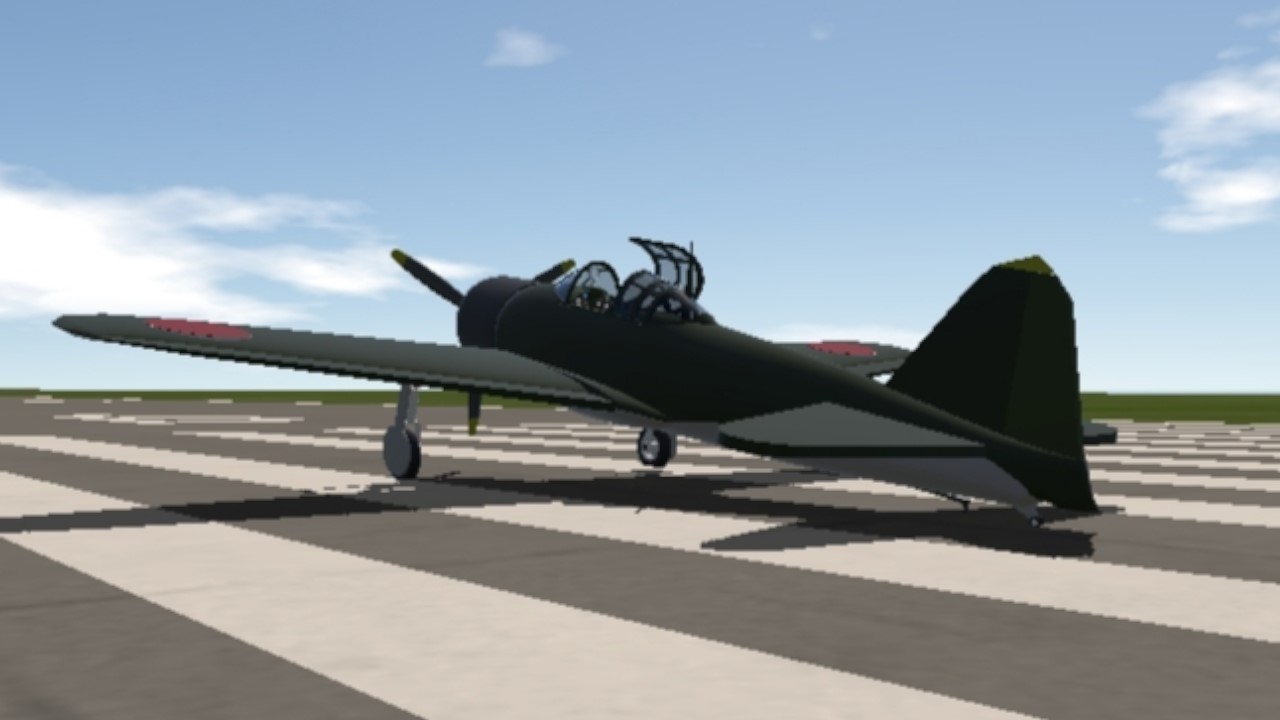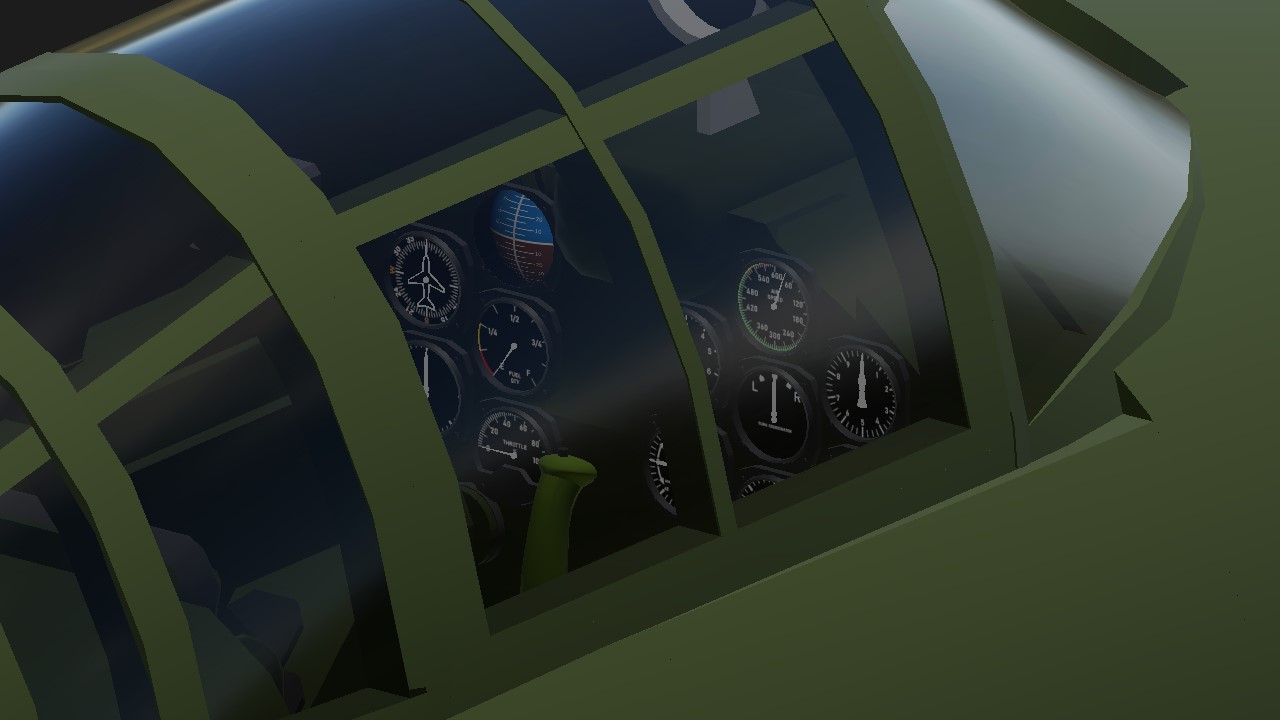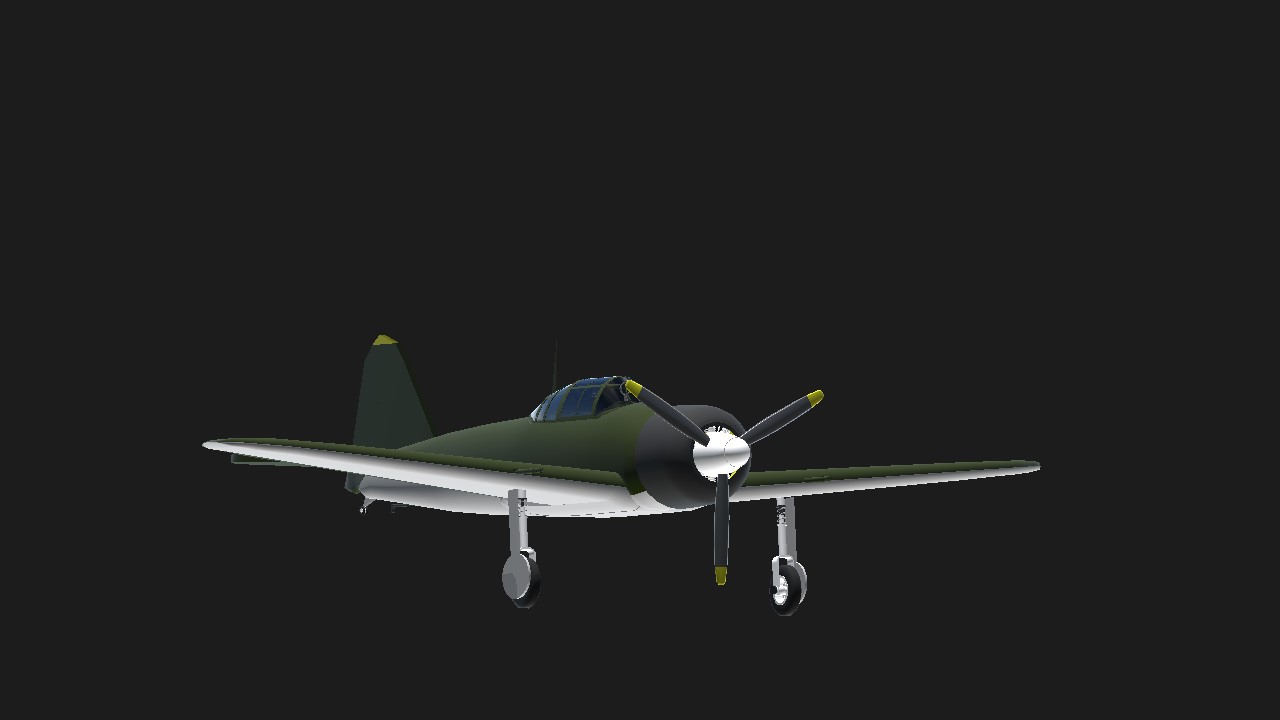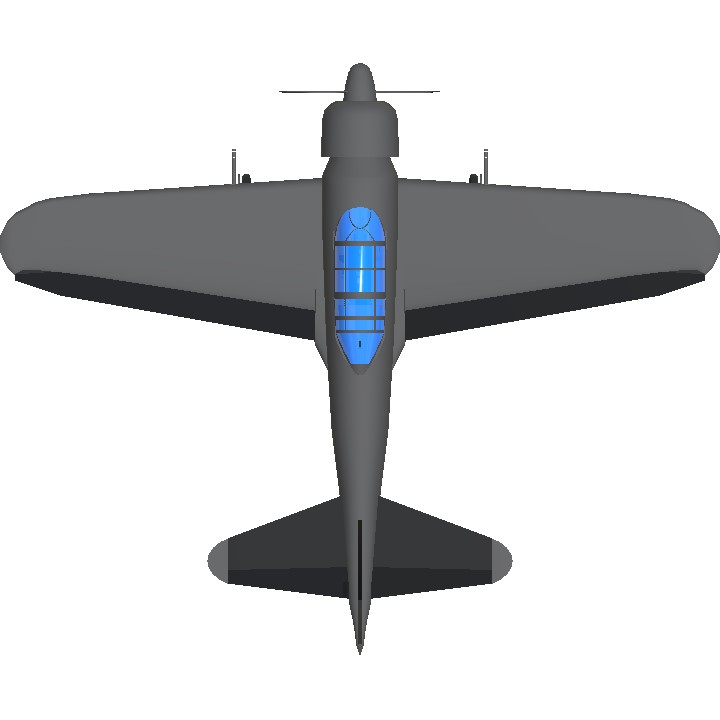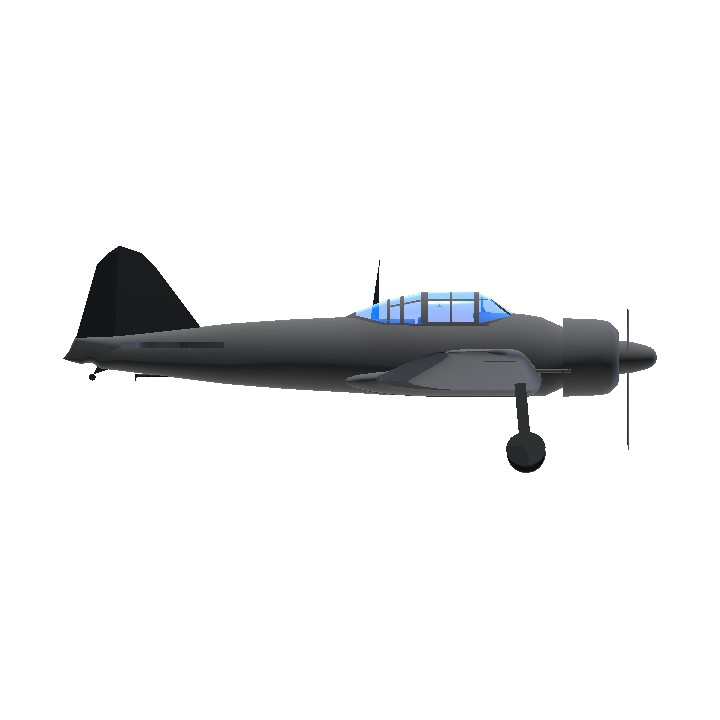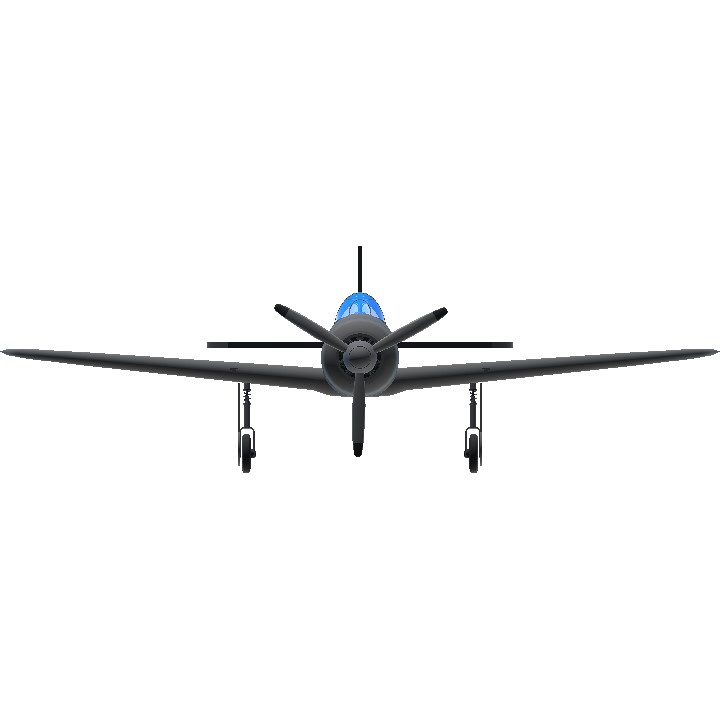The Mitsubishi A6M "Zero" is a long-range carrier-capable fighter aircraft formerly manufactured by Mitsubishi Aircraft Company, a part of Mitsubishi Heavy Industries. It was operated by the Imperial Japanese Navy (IJN) from 1940 to 1945. The A6M was designated as the Mitsubishi Navy Type 0 carrier fighter(零式艦上戦闘機, rei-shiki-kanjō-sentōki), or the Mitsubishi A6M Rei-sen. The A6M was usually referred to by its pilots as the Reisen (零戦, zero fighter), "0" being the last digit of the imperial year 2600 (1940) when it entered service with the IJN. The official Allied reporting name was "Zeke", although the name "Zero" was used more commonly.The Zero is considered to have been the most capable carrier-based fighter in the world when it was introduced early in World War II, combining excellent maneuverability, high airspeed, strong firepower and very long range.The Imperial Japanese Navy Air Service also frequently used it as a land-based fighter.In early combat operations, the Zero gained a reputation as a dogfighter,achieving an outstanding kill ratio of 12 to 1,but by mid-1942 a combination of new tactics and the introduction of better equipment enabled Allied pilots to engage the Zero on generally equal terms.By the middle months of 1943 the deterioration of fighter pilot training in the IJNAS contributed to making the Zero less effective against newer Allied fighters. The Zero lacked hydraulic boosting for its ailerons and rudder, rendering it difficult to maneuver at high speeds. Lack of self-sealing fuel tanks also made it more vulnerable than its contemporaries. By 1944, the A6M had fallen behind Allied fighters in speed and was regarded as outdated but still capable if it had trained pilots. However, as design delays and production difficulties hampered the introduction of newer Japanese aircraft models, the Zero continued to serve in a front-line role until the end of the war in the Pacific. During the final phases, it was also adapted for use in kamikaze operations.Japan produced more Zeros than any other model of combat aircraft during the war.The Mitsubishi A5M fighter was just entering service in early 1937, when the Imperial Japanese Navy started looking for its eventual replacement. On 5 October 1937, it issued "Planning Requirements for the Prototype 12-shi Carrier-based Fighter", sending them to Nakajima and Mitsubishi. Both firms started preliminary design work while awaiting more definitive requirements a few months later.batch of "hillbilly" code names assigned by Captain Frank T. McCoy of Nashville, Tennessee (assigned to the Allied Technical Air Intelligence Unit at Eagle Farm Airport in Australia), who wanted quick, distinctive, easy-to-remember names. The Allied code for Japanese aircraft was introduced in 1942, and McCoy chose "Zeke" for the "Zero". Later, two variants of the fighter received their own code names. The Nakajima A6M2-N floatplane version of the Zero was called "Rufe", and the A6M3-32 variant was initially called "Hap". General "Hap" Arnold, commander of the United States Army Air Forces, objected to that name, however, so it was changed to "Hamp".The Mitsubishi A6M "Zero" is a long-range carrier-capable fighter aircraft formerly manufactured by Mitsubishi Aircraft Company, a part of Mitsubishi Heavy Industries. It was operated by the Imperial Japanese Navy (IJN) from 1940 to 1945. The A6M was designated as the Mitsubishi Navy Type 0 carrier fighter[1] (零式艦上戦闘機, rei-shiki-kanjō-sentōki), or the Mitsubishi A6M Rei-sen. The A6M was usually referred to by its pilots as the Reisen (零戦, zero fighter), "0" being the last digit of the imperial year 2600 (1940) when it entered service with the IJN. The official Allied reporting name was "Zeke", although the name "Zero" was used more commonly.The Zero is considered to have been the most capable carrier-based fighter in the world when it was introduced early in World War II, combining excellent maneuverability, high airspeed, strong firepower and very long range.[2] The Imperial Japanese Navy Air Service also frequently used it as a land-based fighter.
In early combat operations, the Zero gained a reputation as a dogfighter,[3] achieving an outstanding kill ratio of 12 to 1,[4] but by mid-1942 a combination of new tactics and the introduction of better equipment enabled Allied pilots to engage the Zero on generally equal terms.[5] By the middle months of 1943 the deterioration of fighter pilot training in the IJNAS contributed to making the Zero less effective against newer Allied fighters. The Zero lacked hydraulic boosting for its ailerons and rudder, rendering it difficult to maneuver at high speeds. Lack of self-sealing fuel tanks also made it more vulnerable than its contemporaries. By 1944, the A6M had fallen behind Allied fighters in speed and was regarded as outdated but still capable if it had trained pilots. However, as design delays and production difficulties hampered the introduction of newer Japanese aircraft models, the Zero continued to serve in a front-line role until the end of the war in the Pacific. During the final phases, it was also adapted for use in kamikaze operations.[6] Japan produced more Zeros than any other model of combat aircraft during the war.[7]The Mitsubishi A5M fighter was just entering service in early 1937, when the Imperial Japanese Navy started looking for its eventual replacement. On 5 October 1937, it issued "Planning Requirements for the Prototype 12-shi Carrier-based Fighter", sending them to Nakajima and Mitsubishi. Both firms started preliminary design work while awaiting more definitive requirements a few months later.[8]
Based on the experiences of the A5M in China, the IJN sent out updated requirements in October, calling for a speed of 270 kn (310 mph; 500 km/h) at 4,000 m (13,000 ft) and a climb to 3,000 m (9,800 ft) in 9.5 minutes. With drop tanks, the IJN wanted an endurance of two hours at normal power, or six to eight hours at economical cruising speed. Armament was to consist of two 20 mm cannons, two 7.7 mm (.303 in) machine guns and two 60 kg (130 lb) bombs. A complete radio set was to be mounted in all aircraft, along with a radio direction finder for long-range navigation.[9] The maneuverability was to be at least equal to that of the A5M, while the wingspan had to be less than 12 m (39 ft) to allow for use on aircraft carriers.
Nakajima's team considered the new requirements unachievable and pulled out of the competition in January. Mitsubishi's chief designer, Jiro Horikoshi, thought that the requirements could be met, but only if the aircraft were made as light as possible. Every possible weight-saving measure was incorporated into the design. Most of the aircraft was built of a new top-secret aluminium alloy developed by Sumitomo Metal Industries in 1936. Called "extra super duralumin", it was lighter, stronger and more ductile than other alloys used at the time but was prone to corrosive attack, which made it brittle.[10] This detrimental effect was countered with a zinc chromate anti-corrosion coating applied after fabrication. No armour protection was provided for the pilot, engine or other critical points of the aircraft, and self-sealing fuel tanks, which were becoming common among other combatants, were not used. This made the Zero lighter, more maneuverable, and one of the longest-ranged single-engine fighters of World War II, which made it capable of searching out an enemy hundreds of kilometres away, bringing it to battle, then returning to its base or aircraft carrier. However, that tradeoff in weight and construction also made it prone to catching fire and exploding when struck by enemy fire.[11]
With its low-wing cantilever monoplane layout, retractable wide-set conventional landing gear, and enclosed cockpit, the Zero was one of the most modern carrier-based aircraft in the world at the time of its introduction. It had a fairly high-lift, low-speed wing with very low wing loading. Combined with its light weight, this resulted in a very low stalling speed of well below 60 kn (110 km/h; 69 mph). This was the main reason for its phenomenal maneuverability, allowing it to out-turn any Allied fighter of the time. Early models were fitted with servo tabs on the ailerons after pilots complained that control forces became too heavy at speeds above 300 kilometres per hour (190 mph). They were discontinued on later models after it was found that the lightened control forces were allowing pilots to overstress the wings during vigorous maneuvers.[12]The A6M is usually known as the "Zero" from its Japanese Navy aircraft type designation, Type 0 carrier fighter (Rei shiki Kanjō sentōki, 零式艦上戦闘機), taken from the last digit of the Imperial year 2600 (1940) when it entered service. In Japan, it was unofficially referred to as both Rei-sen and Zero-sen; Japanese pilots most commonly called it Zero-sen, where sen is the first syllable of sentōki, Japanese for "fighter plane".[Note 2][13] In the official designation "A6M", the "A" signified a carrier-based fighter, "6" meant that it was the sixth such model built for the Imperial Navy, and "M" indicated Mitsubishi as the manufacturer.
The official Allied code name was "Zeke", in keeping with the practice of giving male names to Japanese fighters, female names to bombers, bird names to gliders, and tree names to trainers. "Zeke" was part of the first batch of "hillbilly" code names assigned by Captain Frank T. McCoy of Nashville, Tennessee (assigned to the Allied Technical Air Intelligence Unit at Eagle Farm Airport in Australia), who wanted quick, distinctive, easy-to-remember names. The Allied code for Japanese aircraft was introduced in 1942, and McCoy chose "Zeke" for the "Zero". Later, two variants of the fighter received their own code names. The Nakajima A6M2-N floatplane version of the Zero was called "Rufe", and the A6M3-32 variant was initially called "Hap". General "Hap" Arnold, commander of the United States Army Air Forces, objected to that name, however, so it was changed to "Hamp".The first Zeros (pre-series of 15 A6M2) went into operation with the 12th Rengo Kōkūtai in July 1940.[14] On 13 September 1940, the Zeros scored their first air-to-air victories when 13 A6M2s led by Lieutenant Saburo Shindo, escorting 27 G3M "Nell" medium-heavy bombers on a raid of Chongqing, attacked 34 Soviet-built Polikarpov I-15s and I-16s of the Chinese Nationalist Air Force, claimed "all 27" of the Chinese fighters shot down without loss to themselves. However Major Louie Yim-qun had in fact nursed his I-15 riddled with 48 bullet holes back to base, and Lieutenant Gao Youxin claimed to have shot down one Zero, but at most 4 Zeroes sustained some damage in the 1/2 hour-long dogfight over Chongqing.[15] By the time they were redeployed a year later, the Zeros had shot down 99 Chinese aircraft[16] (up to 266 according to other sources).[14]
At the time of the attack on Pearl Harbor, 521 Zeros were active in the Pacific, 328 in first-line units.[17] The carrier-borne Model 21 was the type encountered by the Americans. Its tremendous range of over 2,600 kilometres (1,600 mi) allowed it to range farther from its carrier than expected, appearing over distant battlefronts and giving Allied commanders the impression that there were several times as many Zeros as actually existed.[18]
The Zero quickly gained a fearsome reputation.[3] Thanks to a combination of unsurpassed maneuverability—compared to contemporary Axis fighters—and excellent firepower, it easily disposed of Allied aircraft sent against it in the Pacific in 1941.[19][20] It proved a difficult opponent even for the Supermarine Spitfire. "The RAF pilots were trained in methods that were excellent against German and Italian equipment but suicide against the acrobatic Japs", as Lieutenant General Claire Lee Chennault noted.[21] Although not as fast as the British fighter, the Zero could out-turn the Spitfire with ease, sustain a climb at a very steep angle, and stay in the air for three times as long.[22]
Allied pilots soon developed tactics to cope with the Zero. Because of its extreme agility, engaging a Zero in a traditional turning dogfight was likely to be fatal.[23] It was better to swoop down from above in a high-speed pass, fire a quick burst, then climb quickly back up to altitude. A short burst of fire from heavy machine guns or cannon was often enough to destroy the Zero, provided that some hits rupture the fuel tanks. These tactics were regularly employed by Grumman F4F Wildcat fighters during Guadalcanal defense through high-altitude ambush, which was possible with an early warning system consisting of coastwatchers and radar.[24] Such "boom-and-zoom" tactics were also successfully used in the China Burma India Theater by the "Flying Tigers" of the American Volunteer Group (AVG) against similarly maneuverable Japanese Army aircraft such as the Nakajima Ki-27 "Nate" and Nakajima Ki-43 "Oscar". AVG pilots were trained by their commander Claire Chennault to exploit the advantages of their P-40 Warhawks, which were very sturdy, heavily armed, generally faster in a dive, and level flight at low altitude, with a good rate of roll.[25]
Another important maneuver was Lieutenant Commander John S. "Jimmy" Thach's "Thach Weave", in which two fighters would fly about 60 m (200 ft) apart. If a Zero latched onto the tail of one of the fighters, the two aircraft would turn toward each other. If the Zero followed his original target through the turn, he would come into a position to be fired on by the target's wingman. This tactic was first used to good effect during the Battle of Midway and later over the Solomon Islands.
Many highly experienced Japanese aviators were lost in combat, resulting in a progressive decline in pilot quality, which became a significant factor in Allied successes. Unexpected heavy losses of pilots at the Battles of the Coral Sea and Midway dealt the Japanese carrier air force a blow from which it never fully recovered.[26][27]
Activation Group
AG-1>Open Cockpit
AG-2>Turn On Engine
AG-3>Deploy Arresting Hook
Specifications
General Characteristics
- Created On Android
- Wingspan 39.1ft (11.9m)
- Length 32.2ft (9.8m)
- Height 12.3ft (3.7m)
- Empty Weight 10,436lbs (4,734kg)
- Loaded Weight 11,434lbs (5,186kg)
Performance
- Horse Power/Weight Ratio 0.426
- Wing Loading 49.1lbs/ft2 (239.8kg/m2)
- Wing Area 232.8ft2 (21.6m2)
- Drag Points 3320
Parts
- Number of Parts 187
- Control Surfaces 10
- Performance Cost 806

